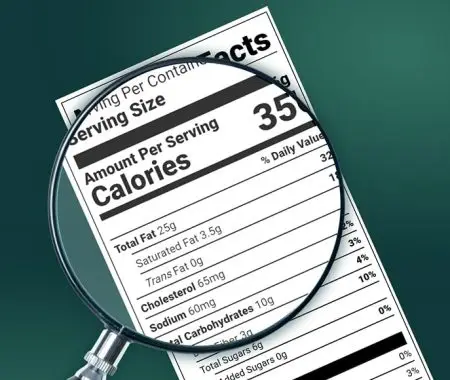In Canada’s food marketing industry, health claims on food labels have the power of significantly influence consumer health choices. These claims range from statements about the nutrient content in food products to claims about the food offering certain health benefits. Recognizing their impact, the Canadian Food Number Inspection Agency (CFIA) strictly regulates these claims to ensure accuracy, reliability, and trust between product and consumer. This regulatory oversight prevents misleading information and requires all health claims to be backed up by scientific evidence. As Canadians become more health-conscious, the importance of these regulations continues to grow. As a business of manufacturer, you need to ensure that the health claims on your food packages align closely with CFIA guidelines for public safety and compliance purposes.
TLDR
- Understanding CFIA Regulations: The CFIA has set strict regulations to prevent misleading health claims on food labels, ensuring consumer safety and maintaining trust.
- Types of Permissible Health Claims:
- Nutrient Content Claims: Focus on the level of nutrients, like “low in fat.”
- Health Claims fall into other categories:
- Function Claims/Nutrient Function Claims: Describe the positive or negative effects of nutrients on normal bodily functions.
- Disease Risk Reduction Claims: Links food components with reduced risk of diseases.
- Therapeutic Claims: Related to the treatment or management of a disease and for an improved lifestyle.
- Substantiating Health Claims: Claims to be supported by solid, scientific evidence, including human clinical trials, systematic reviews and plausability.
- Navigating the Approval Process: There are a number of steps that need to be followed to obtain approval for new health claims, from pre-submission consultations to post-approval monitoring.
- Food Label Maker’s Role in Compliance: Food Label Maker assists businesses in ensuring that their labels meet CFIA regulations, with tools for creating compliant labels and automated checks.
Understanding CFIA Regulations
As stated, the CFIA have strict regulations on food labels, especially when it comes to health claims made regarding food products. A health claim on food labels or in general advertising refers to any statement or suggestion that links eating a specific food to health benefits or effects. If not supported by scientific evidence, they can be misleading or inaccurate for consumers. The CFIA regulations have been put in place to help prevent misinformation that could lead customers to make poor health choices. Additionally, they ensure that manufacturers remain honest and transparent about the benefits of their products.
See How FoodLabelMaker Can Help You
Types of Permissible Health Claims
In Canada, the types of health claims that can be made on food labels are closely regulated by the CFIA and Health Canada. Here’s an overview of the different types of permissible health claims:
Nutrient Content Claims
These describe the level of a nutrient in a food item that you typically want more of or to avoid outright, such as “low in fat,” “source of magnesium,” or “high in fibre.” They help consumers understand the nutritional composition of a food product relative to a nutrient’s daily intake level.
Health claims are broken down into:
Function Claims or Nutrient Function Claims
These describe the benefits or positive effects that a nutrient or food would have for normal bodily functions or biological activities. An example would be “Vitamin C supports the immune system”.
Disease Risk Reduction Claims
These link the consumption of a food or food constituent to the reduced risk of developing a disease, with statements like “Consuming whole grain products as part of a healthy diet may help reduce the risk of heart disease.”
Therapeutic Claims
These are similar to disease risk reduction claims in that they are associated more closely with the treatment or prevention of a disease and can improve a person’s daily life. For example, “Probiotics help manage lactose intolerance symptoms by aiding digestion”. This could also be seen as a Probiotic claim, wherein the probiotic microorganisms found in food products can have certain health benefits for a consumer.
To legally make these claims, companies must ensure that they are substantiated by credible scientific evidence, and in some cases, may require pre-market approval from Health Canada. Health claims must also be clear, accurate, and not misleading, providing real benefits that can be understood and accessed by consumers.
For further details on health claims on food labels in Canada, you can visit the CFIA’s overview of health claims and Health Canada’s guidance on nutrient content claims.
Substantiating Health Claims with Scientific Evidence
To substantiate health claims on food labels in Canada, it is crucial that these claims are supported by credible and rigorous scientific evidence. The CFIA requires that all health claims be based on sound and comprehensive research so that they don’t mislead consumers into thinking that a food product has a particular benefit when in actual fact it does not. Here are the types of studies and data that are typically required:
- Human Clinical Trials: These are considered the gold standard for substantiating health claims. Trials should be well-controlled and randomized where applicable, to minimize any bias or favouratism that might occur. This is so that any observed health benefits can be directly attributed to the food or ingredient in question, rather than other external factors.
- Systematic Reviews and Meta-Analyses: These studies compile data from multiple research papers to confirm consistent effects across different populations and settings.
- Quality over quantity: At least two objective and thorough studies are required to demonstrate the claim made of a food. So instead of conducting many trials, there only needs to be two relevant and strong studies to prove a case.
- Plausibility and Mechanism: It’s important that the health claim is biologically plausible and backed up by a scientifically acceptable explanation for how the food or ingredient causes the claimed health effect. Understanding the biological mechanism involved can significantly strengthen the claim.
- Final Regulatory Sign Off: Once the evidence is gathered, it must be reviewed and approved by regulatory bodies, Health Canada or the U.S. Food and Drug Administration (FDA), to ensure that the claim is supported by credible scientific proof and meets all regulatory requirements.
These studies should be published in peer-reviewed scientific journals so that they add to the scientific community. This robust approach ensures that the health claims made are not only compliant with CFIA regulations but also reliable and beneficial for consumer knowledge.
Navigating the Approval Process
Successfully navigating the approval process for new health claims involves a structured and methodical approach. Here are several key steps, from initial consultation to final approval and ongoing monitoring, based on guidelines from Health Canada:
Pre-submission Consultation: Engaging with the CFIA during the early stages of developing a health claim can provide valuable guidance and clarify the requirements and expectations.
- Pre-Submission Consultation:
- Engage Early: Before submitting your health claim for approval, it would be helpful to consult with the CFIA. This can provide valuable guidance on the requirements and expectations for your submission.
- Clarify Your Claim: Discuss the specifics of your health claim, including the proposed wording and the scientific evidence you intend to provide.
- Preparing Your Submission:
- Compile Robust Evidence: Your submission should include comprehensive scientific data to support your health claim. This includes clinical trial data, and other relevant research that demonstrates the health benefits of your product.
- Ensure Compliance: Make sure your submission adheres to the guidelines set out by Health Canada, which include detailed requirements on the nature of the evidence and the presentation of the health claim.
- Submission Review:
- CFIA Assessment: After submission, the CFIA will review your application to ensure that the claim is supported by the evidence and complies with Canadian food labeling regulations. It takes 15 days after submission for Health Canada to receive your application, by which they will then either approve your health claim or re-evaluate your claim.
- Address Feedback: Be prepared to respond to feedback from the CFIA, which may include requests for additional information or clarification on certain points.
- Approval and Implementation:
- Receiving Approval: If your health claim meets all regulatory requirements, you will receive approval to use the claim on your product labeling. Ensure that you do not deviate from the approved claim in any way and use the exact wording approved by the CFIA.
- Monitoring and Compliance:
- Post-Approval Monitoring: Keep in mind that compliance monitoring continues even after approval. The CFIA may conduct periodic reviews to ensure ongoing compliance with labeling regulations.
- Report Changes: If there are any changes to your product that could affect the validity of the health claim, you must report these changes to the CFIA and possibly re-evaluate the claim.
Navigating the health claim approval process requires careful planning and adherence to regulatory guidelines. For more detailed guidance, you can refer to Health Canada’s Guidance Document for Preparing a Submission for Food Health Claims.
How Food Label Maker Facilitates Compliance
Understanding the nuances and regulatory requirements of health claims on food labels can be difficult for a business in the industry. This is why a platform like Food Label Maker comes in handy. They create fully compliant nutrition labels with a suite of comprehensive tools and software. Here are a few other ways in which they help businesses thrive:
- Customizable Templates: They provide templates that are pre-configured to include specific approved health claims. This ensures that labels meet all legal requirements without additional formatting.
- Automated Compliance Checks: Their platform automatically reviews the labels against current CFIA regulations, alerting users to any non-compliance issues that need to be addressed.
- Up-to-date Regulations: Food Label Maker keeps their finger on the pulse with the latest regulatory changes. Their Regulatory Hub provides helpful resources on the ever changing landscape of CFIA standards.
By using Food Label Maker, businesses can significantly streamline their label creation process, reduce the risk of compliance issues, and ensure that their products meet the highest standards of labeling accuracy and reliability.
Conclusion
Complying with CFIA’s health claim regulations is essential for manufacturers to ensure their product labels are accurate and based on solid scientific evidence. These guidelines not only bolster public trust in food labeling but enhance public health by avoiding misleading claims.
To aid in maintaining compliance, using tools like Food Label Maker can be incredibly beneficial. They offer customizable templates and automated compliance checks which simplify the label creation process. This helps businesses adhere to regulatory standards effectively while ensuring their products are appealing to consumers in the Canadian market.
FAQs
Do health claims on food labels require approval?
Yes, most health claims on food labels in Canada require approval from Health Canada or the Canadian Food Inspection Agency (CFIA). This is so that any claims made are based on sound scientific evidence and do not appear misleading or untruthful to consumers.
What are four example health claims on the food label?
- Function Claim / Nutrient Content Claim: “Vitamin A aids normal bone and tooth development”
- Disease Risk Reduction Claim: “Consumption of omega-3 fatty acids may reduce the risk of coronary heart disease.”
- Therapeutic Claim: “Regular consumption of psyllium fiber helps relieve constipation.”
What are function claims on food labels?
Function claims are statements on food labels that describe the role that a nutrient or dietary ingredient plays in maintaining normal bodily functions, growth, and development. For example, “Fiber promotes bowel regularity,” or “Iron is a factor in red blood cell formation”.



